
The list of America’s Favourite Works of Architecture is dominated by three cities I the northeast and one 9n the Midwest. New York has 32 places on the list (SPOILER ALERT) including #1 the Empire State Building. Chicago has 17 one more than Washington D.C. The list is especially top heavy with NYC and DC with only 5 of the top 23 outside their city limits. But a closer inspection of the rest of the list reveals a number of unjustly relegated gems masterpieces who deserve to be celebrated, along with the men who built them. And yes they are all men but that’s another issue. But get introduced to some of the giants of the 20th center. Eero Saarinen. Richard Meier whose work looks like he graduated from the Starfleet Academy in Star Date 2214.9. Fay Jones who described his work as “Ozark Gothic.” Also, meet three sports venues. One each for hockey, baseball and football. Basketball didn’t make the cut. Many of them reflect the Iron Law of Retail: Three things matter. Location. Location. Location. You might think that if a great building were in Manhattan as opposed to say, Eureka Springs, Arkansas it might have been nearer the top. In any case here are 20 reasons why the non-Northeast hinterland is well stocked with iconic architecture.
Advertisement
20. Ingalls Ice Arena, Yale University – New Haven, CT #149
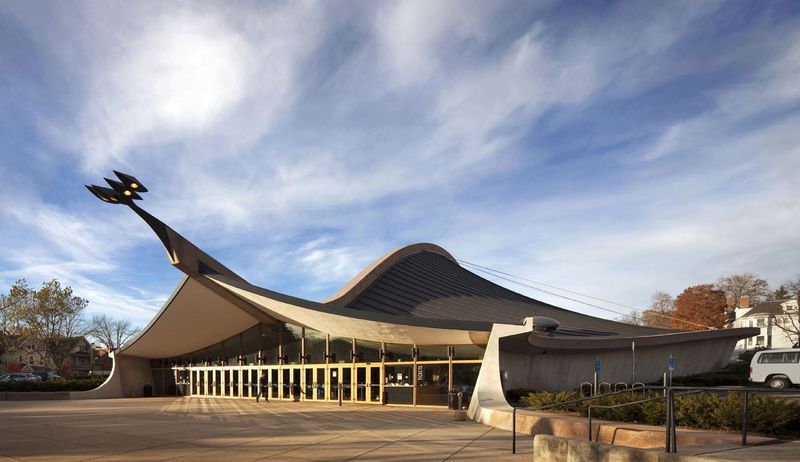
Barely made the cut but really, how many chances are there to put a hockey rink on a list of memorable works of architecture? Answer: one. At its unveiling in 1958 it was disparagingly nicknamed The Yale Whale for tis double curve and tail. It was designed by the Finnish-American and Yale alumnus Eero Saarinen one of the greatest architects of the 20th century. The structure is unique and for its time innovative. A concrete arch supported by a cable net and later cable ties made for a marvel of engineering. Canadian hockey fans may be reminded of the Calgary Saddledome decades later. Interesting that he Top 150 list contains a number of baseball stadiums and a football stadium but no basketball venues or other historic venues such as Madison Square or Boston Garden.
19. Brown Palace Hotel – Denver 148

When the famously triangle-shaped Brown Palace opened its doors in 1892, the term Wild West was still appropriate. The iconic hotel was the height of sophistication with rare luxuries like a bathroom in every room. One Denver website says the historic and gorgeous lobby ” with its turn-of-the-century luxury finishes and the dazzling stained glass roof” qualifies as a Historic Landmark on its own. The architect F.E. Edbroke used Arizona sandstone and local Colorado red granite crafted in the Italian Renaissance style. Never mind it has hosted royalty, every U.S. President but wo and he Beatles, it was here the God known as legendary Bronco quarterback John Elway had lunch before signing the hometown Broncos. Now THAT is true immortality.
18. Corning Museum of Glass – Corning, NY #136
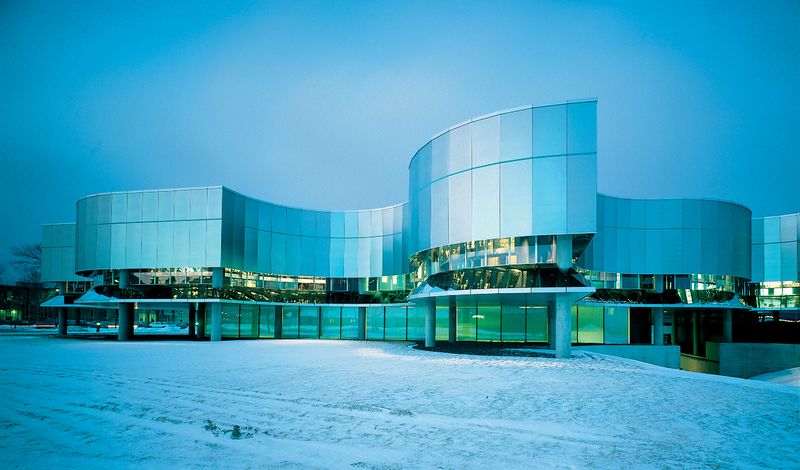
The Corning company campus in upstate New York is a magical enclave of glass buildings designed and built by notable architects over three generations. What began as a single low building with walls made of (what else?) glass, its fabulous collection grew and necessitated extensions which are works of art on their own in 1980, 2002 and the latest in 2015. It is a stark white box which on closer inspection reveals an intricate layering of glass sheets, with white and grey silicon. The renowned collection of artifacts dating back 3,500 years, the website says the entire history of art through a single material.”
17. Safeco Field – Seattle 135

Though 15 years old “The Safe’ is still a state of the art facility. It presents itself with a curved brick facade retro homage to the great ballparks of old, like Ebbetts Field and Yankee Stadium. Some regard the juxtaposition with the ultra-modern facets of the rest an ungainly hybrid. The unique 22 million pound retractable roof protects field and fans from inclement weather. An underground heating system induces the 7 grass blend of Kentucky blue and perennial rye to turn green by opening day. It affords grand views of the Seattle skyline and Puget Sound. More importantly, the sightlines for fans are among the highest-rated in the league and player testimonials are glowing. Maybe the more the Mariners on field product is a winning one the better everyone feels about the park.
Advertisement
16. Douglas House – Harbor Springs, MI Richard Meier #130

If you haven’t met before, welcome to the wild, white world of Richard Meier one of architecture’s towering geniuses. Architecture aficionados will note the influences of Le Corbusier and Miles van de Rohe in the building and the furniture which Meier also designed. It is an extremely ambitious structure, packing a lot into its small residential size. The material is reinforced concrete. The front faces a the rock wall of the shore while the four-story back faces Lake Michigan and provides floor to ceiling views with stairways tucked away in corners. With a skylight on top and unimpeded views of the lake make it an exercise in sublime space, a futuristic enclosure springing from primordial lakeside bedrock.
15. Union Station Kansas City #127

The beautiful BeauxArts station was the second largest in the U.S when it opened in the fall of 1914. It was huge, 850,000 square feet and 95 feet up to is gloriously ornate ceiling with a trio of chandeliers each weighing 3500 pounds. But it withered as traffic dried up, dropping from almost 700,000 in 1945 to just 33.000 in 1973. By the 90’s, the website says, “was a broken and empty shell begging for attention.” When government decided to save it, the assembled an all- star team for what was more of a resurrection than restoration. Much of the roof had to be replaced with tiles of the exact same shape and color. The grand chandeliers were rewired, the original paint color was reproduced. The tram included experts who had work on restoration projects on Windsor Castle, Grand Central Station, and the Lincoln Memorial. Now the Station is alive and thriving with shops, restaurants and a Science Center, an architectural Lazarus brought back from the dead.
14. The Athenaeum – New Harmony, IN

Another striking exercise in white by Richard Meier New Harmony began life in 1814 as utopian community founded by a group of dissenting Germans who formed the New Harmonie Society before selling to a wealthy industrialist who made it a model community for education and social justice. As it came to be called the Athens of the West, Meier’s gateway porcelain-paneled building was called The Athenaeum… The AIA nomination called it building “one of Meier’s seminal works of architecture … a classic Meier design.” Visitors are taken up through 3 floors of exhibits to a fourth floor panorama of the Indiana flatlands and Wabash River before being led down exterior ramps to town, as if transitioning from our deeply-flawed world mankind has made to the utopian dream ha might have been.
13. Humana Building – Louisville, KY Michael Graves, #98
The 26- story post-modern skyscraper opened in 1985 and has won multiple awards for architect Michael Graves, one of the greatest interpreters of the style. TIME Magazine listed it as one of the 10 best buildings of the 1980’s. Most of the exterior its pink granite and gold leaf. It is a building with many faces and styles, each side being different. Its eight-floor Main Street façade mirrors the low-rise historical buildings alongside.

Above it explodes into energetic collisions of loggia and colonnades. The interior office space with tis modern statues and marble finishes is immaculate and looks more like the residence of a billionaire with impeccable taste than a place where people actually work. Graves did have his playful side. Humana was once dubbed The Milk Carton for its unusual shape(s). He also designed a postmodern teakettle for Target.
12. United States Courthouse, Islip NY #97

Yes another example of the Whiter Shade of Richard Meier. Islip is an historic town on the south coast off Long Island that opened in 2000. For a change, here is the building in his own words. “This federal courthouse takes advantage of panoramic views over both the Great South Bay and the Atlantic Ocean. The 12-story building is placed on a podium to gain an extra presence on an otherwise flat and undifferentiated suburban site. Visitors ascend two wide tiers of steps and enter the building through a monumental 9-story, top-lit rotunda in the form of an opaque cone clad in white metal panels. The rest of the south elevation consists of a gently inflected curtain wall that allows light into the corridors and permits uninterrupted views of the ocean. The north façade is faced with metal panels and pierced by horizontal windows. This building reinterprets the courthouse as a new type of civic institution, receptive to public events as well as to the formalities of the judicial process. The terraced forecourt, articulated by a modulated surface and rectilinear plantings of trees, provides an appropriate setting for a building of such civic stature.
Advertisement
11. Dolphin and Swan Hotels, Walt Disney World Orlando #70

Before you roll your eyes at the inclusion of Disney hotels as some kind of déclassé architectural comfort food like Kraft dinner, rest assure this is a serious, if whimsical piece of architecture by Michel Graves, the same man who revolutionized the skyscraper with he Urbana building in Louisville. He began by creating a whole new mythical story with no existing Disney characters. Once upon a time, a submerged island was suddenly propelled to the surface with the dolphins on top and two birds who went in for closer inspection were transformed into swans, in this case, 28 ton 47 feet high swans. The dolphins were inspired by the master Italian sculptor Gian Lorenzo Bernini whose work will be known to anyone who has had the good fortune to stroll the Piazza Navona in Rome. The dolphin subplot is ha Bernini’s frowned and Disney ownership insisted they put on a happy face. And there was no skimping on materials. European-made chandeliers with accents of Asian Golden Onyx and tropical Pao rosewood. As Mickey would say, “Oh boy, that sure is swell.”
10. Salt Lake City Public Library #69

Born in Israel, educated in Canada and based in Boston, architect Moshe Safdie burst onto the international scene before the age of 30 with his stunning design of the model housing complex, Habitat, a centerpiece of the 1967 World Exposition in Montreal. The dazzling library is a good deal more transparent that allows for lovely natural light and views of the Wasatch mountains. A virtuoso performance in glass and geometry has one building a triangle, another wing a rectangle enclosed with a crescent. At the base is a garden in a piazza and on top is a roof garden. Fireplaces swirling four floors up resemble a wall of flame at night from some angles. The windows though extensive have a very high UV rating for energy efficiency and are the sunblock for the library’s book collection.
9. Nebraska State Capital – Lincoln, NE #67

The Nebraska State Capitol building is ground breaking in more than one way. It was the first to be built as a tower. Perhaps more importantly I was far ahead of is time incorporating and paying tribute to the indigenous cultures of the plaints Indians. In parts Gothic and Byzantine Revival in style, the 400t foot tower is crowned by a massive figure The Sower” the people who came to plant and grow the crops and the very state itself. Inscriptions dot the exterior drawing on quotes from Aristotle, Plato and Navajo school wisdom.The doors to the East Chamber are especially striking and memorable together weighing the better part of a ton, eloquently commemorating the culture of the Plains Indians that the Americans and Europeans displaced…
8. Thorncrown Chapel – Eureka Springs 60

If any place can be said to be The Middle of Nowhere, Eureka Springs might be it. Two hundredf miles north of Little Rock, 250 east of Oklahoma City and 300 southeast of St. Louis It is also a renowned as a centre for the Arts with a School of the Arts, Writers’ Colony, dance studio Opera and Shakespeare in the Ozarks. A fitting home to one of the greatest architectural creations of the 20th century, the chapel which award- winning designer and Frank Lloyd Wright disciple Fay Jones jokingly labelled “Ozark Gothic. Its inspiration was the truly fabulous real Gothic 13th century Ste Chappelle in Paris. Thorncrown does not have Ste Chappelle’s incomparable stained glass but instead uses a starkly beautiful design, 425 windows and the light of the Ozark countryside as its ‘organic’ stained glass, changing hue and colour .As its website describes, and “Its appearance changes during each hour of the day and during the different seasons of the year.” A classic example of organic architecture, it appears to be ‘of’ the place not ‘on’ it.
7. Milwaukee Art Museum – Milwaukee # 59

Spanish architect Santiago Calatrava was asked to undertake the daunting task to design and build an addition to the Museum’s striking original bui8lding dopne by the great Eero Saarinen who you’ve already met here. He succeeded in a spectacular post-modern manner. The Quaddraci pavilion (named after its primary donors) is huge. Just the Gothic Cathedral-style entrance hall can hold a two-story house. It is a unique combination of technology and craftsmanship. There are many nautical visual references. A ship’s prow, a remarkable set of steel fins, called the Burke Brise Soleil (literally) “sun break” up to a 105 feet in length and weighing 90 tons which Calatrava called the crowning element. Engineered to close automatically whenever wind speed exceeds 23 mph for more than three seconds, they also deploy and close each morning, noon and evening, thereby achieving his desire to reflect “he culture of the lake: the sailboats, the weather, the sense of motion and change.”
Advertisement
6. Denver International Airport – Denver #57
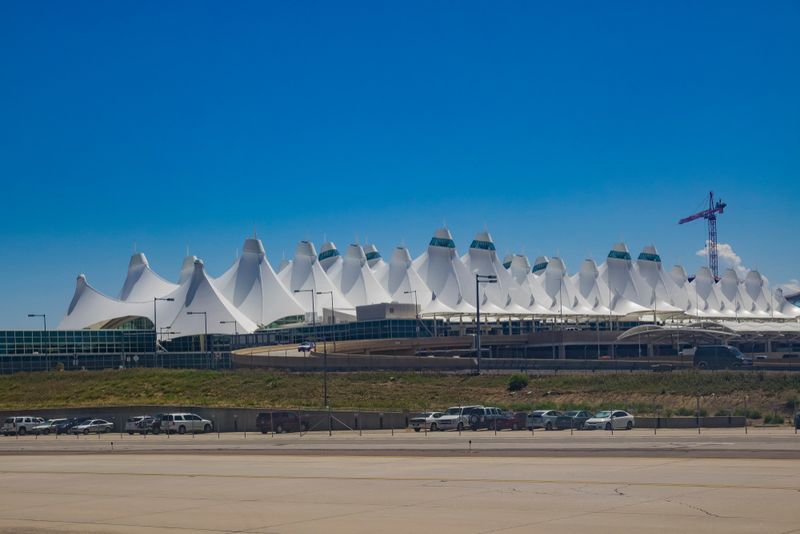
At first the DIA was infamous for its ambitious computerized baggage system that ate whatever it didn’t lose outright. It took 10 years for airlines to abandon it for good. Now, it’s famous for the peaked roof of the Jeppesen terminal that is reminiscent of the iconic Sydney Opera House, but in fact is a now world-famous rendition of the snow-capped Rockies that also evokes the pioneers’ wagons and Indian tepees. It is white but also green. Its translucence allows for generous amounts of natural light while its coating reflects 90% of the heat. The cable systems draws on that of the Brooklyn Bridge more than a century earlier. Also famous is a pedestrian that offers views of the Rockies above and taxiing planes below. With the addition of a solar energy farm, DIA has become a world leader in airport sustainability management. Architect Curtis Fentress , a disciple of the great Chinese American architect I.M. Pei, has gone on to build award-winning airports around the world.
5. Cincinnati Paul Brown Stadium – Cincinnati #45

The Cincinnati may not deliver a world-class product on the field, but the stadium they play in does. The intensely deconstructed design is a standout on the city skyline, especially at night when the lighting system and canopy of Teflon-coated fibreglass make it glow like an alien ladybug. Aside from excellent sightlines foe game action, fans can take advantage of the totally asymmetrical open-ended structure to gaze at the city skyline and riverfront during lulls in the action. From some side angles, the design can seem to recall Marcel Duchamp’s Modernist 1912 classic Nude Descending a Staircase, No. 2, though any resemblance may simply be in the eye of some beholders pushing the beer limit.
4. Old Faithful Inn – Yellowstone National Park #36
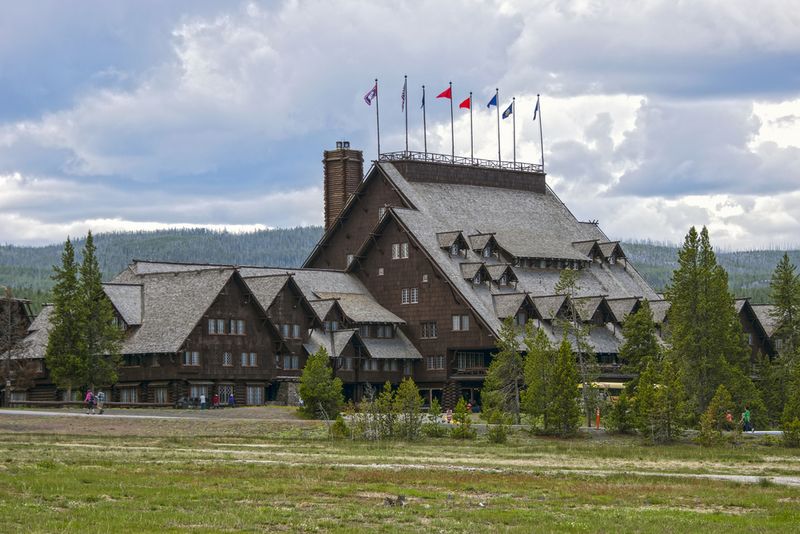
Not a post-modern shred to be seen here. The national historic stone and log landmark dates from 1905 and is the most popular in the park. It is also the biggest log structure in the world. But it’s not famous for size or scale but for its rustic sensibilities like the huge stone fireplace in the lobby, (though it is some lobby at 76 feet in height) and of course for its proximity to Old Faithful. The original part of the Inn, referred to as the “Old House,” is a splendid example of well-preserved so called National Park architecture and is listed on the National Register of Historic Places.
3. Allegheny County Courthouse – Pittsburgh #35

So compelling was Boston architect HH Richardson’s interpretation of the Romanesque Revival style, it was named after him. While the Allegheny County Courthouse may sound prosaic, Richardson considered it his finest work and one that deeply influenced future superstars like Frank Lloyd Wright and his onetime boss Louis Sullivan. The roughened surface of the granite blocks under a weight and bearing that give it an appearance of the immovable object of physics fame. The courthouse is connected in midair to a prison by “The Bridge of Sighs”, the term given by Byron to a similar link in Venice where prisoners would sigh with regret as the last sight the canals of the Great City. Though Grant Street in Pittsburgh is not be confused with the Grand Canal, it’s a lovely classical reference.
2. Wanamaker’s Department Store – Philadelphia #32
Still a Philly landmark, the dedication of the huge department store was delivered by President Taft. John Wanamaker had opened his clothing store 60 years earlier. The structure at 13th and Market streets was one of the first true department store in the country.one of the first in the country.

The exterior has been variously described as Renaissance palace and Florentine is quite plain in limestone and granite. But inside, the space was spectacular, the central court soaring five stories with eccentric features like the giant Wanamaker organ. It is the most impressive interior space in any commercial building in the city and contains the Wanamaker Organ from the St Louis World fair which joined forces with another St Louis souvenir in the beautifully-marbled Grand Court, the large Bronze Eagle. If today Philadelphians might say “Meet me at the Rocky Statue”, back then Wanamaker shoppers (which were just about everyone) would say “Meet me at the Eagle” and the rendezvous was set.
Advertisement
1. Bellagio #22
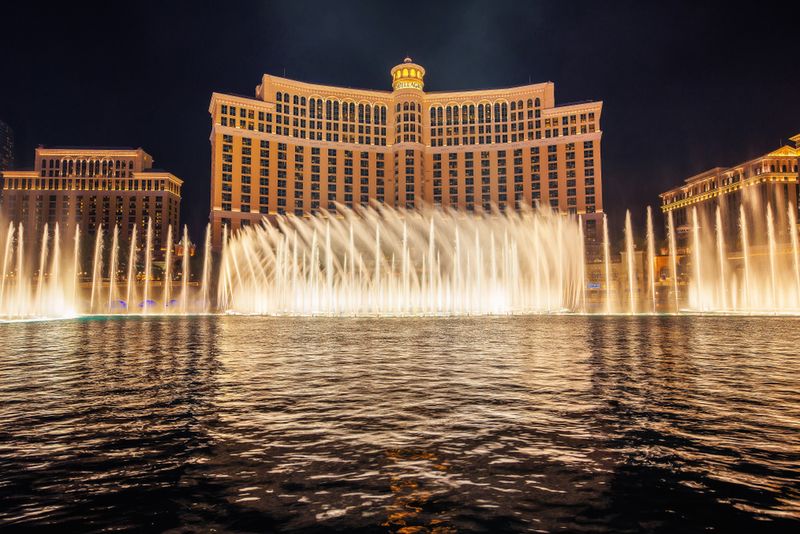
Anyone who has actually been to the town of Bellagio in Italy’s Lake District, may struggle to see the resemblance. Bellagio is a collection of Renaissance architecture plunked on the shores of a lake whose setting resembles a piece of pristine Pacific Northwest forest, a setting not even Steve Wynn’s considerable wallet can reproduce in Las Vegas. It does have an impressive scale. The original tower is over 500 feet tall with a staggering 3000 rooms. Standing in for Lake Como an eight-acre body of water leading out to The Strip which features the Dancing Water Fountain that rises and falls to music. There is elegance to be had within too, especially the beauty of the blown glass instillation Fiori di Como (Flowers of Como). At #22, Bellagio is sandwiched by some high-powered American icons, the Brooklyn Bridge at #20 and St. John the Divine cathedral at 23.
Advertisement